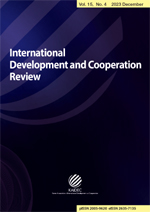
12 Years of Aid Allocation Practice in Korea: Disparities in Accordance with Recipients’ Merits with the Lorenz Curve
12 Years of Aid Allocation Practice in Korea: Disparities in Accordance with Recipients’ Merits with the Lorenz Curve
연구목적: 본 연구는 한국 정부의 원조 배분에 차이(disparity in aid allocation)가 존재하는지 검토하고 한국 정부가 실질적으로 적용한 원조 배분 전략을 실증적으로 분석하는 데 목적을 두고 있다. 연구의 중요성: 기존의 원조 할당에 관한 연구는 ‘RN-DI 모델’을 기반으로 수원국의 필요도와 공여국의 이익을 반영하여 공적개발원조가 개발도상국에 할당되었는지 검토하는 것에 초점을 맞추었지만, 해당 모델을 기반으로 한 결과는 편향되었을 가능성이 제기되었다. 이에 따라, 본 연구는 ‘수원국의 장점(Recipients’ Merit Model)’을 기반으로 원조 할당에 격차가 존재하는지 실증적으로 분석하는 계기를 마련하고자 한다. 또한, 해당 연구는 로렌츠 곡선 및 지니 계수를 활용하여 원조 배분에 있어 상대적인 측정의 단순성(simplicity)과 형평성에 대한 단일 가치(single value)를 제시하고자 한다. 연구방법론: 본 연구는 원조 할당에 대한 격차를 분석하고자 3가지 이론적 틀(수원국의 필요; 공여국의 이익; 수원국의 장점)을 활용하였으며, 12년(2010~2021년) 동안 할당된 원조 금액의 불균형을 실증적으로 분석하고자 지니 계수 및 로렌츠 곡선을 활용한다. 연구결과: 분석 결과, 한국 정부는 수원국의 장점을 바탕으로 해외 원조를 제공했으며, 원조 배분의 차이는 수원국의 필요 및 공여국의 이익보다는 개발도상국의 거버넌스에 기인한 것으로 나타났다. 즉, 한국의 ODA는 수원국의 책무성 수준(accountability)에 따라 차이를 두고 할당되었으며, 책임성의 수준이 낮을수록 ODA 배분의 격차는 더 커진 것을 확인하였다. 결론 및 시사점: 이러한 연구결과는 한국 정부가 원조 효과성 증대 및 세금 낭비 방지를 위해 거버넌스 수준을 기반으로 대외 원조 규모에 격차를 조성하기로 결정했다는 점을 강조함으로써 시민들이 대외 원조 증가에 동의하 도록 실증적 증거로서 역할을 수행할 수 있을 것으로 판단된다.
Purpose: This paper has examined whether there is disparity in aid allocation funded by the Korean government and sought to answer a number of salient questions on strategies in practice. Originality: The previous research on aid allocation tends to explore factors and declares that assistance has been allocated to developing countries, with a focus on the level of recipients’ needs and donors’ domestic interests based on the ‘RN-DI model’, whereas it is expected that the findings on aid allocation based on the RN-DI model have been presented with biased results. Hence, this study attempts to build momentum to analyze if there appear to be disparities in aid allocation based on the ‘Recipient Merit’. Furthermore, using the Lorenz curve, this article aims to pursue its relative simplicity to measure and the ability of the Gini Coefficient to offer a single value of overall equity in aid allocation. Methodology: The framework used to analyze and compare the level of disparities in aid allocation comes from different perspectives: (1) recipients’ needs; (2) donors' interests; and (3) recipients’ merit. It analyzes disparities in aid allocation over a 12-year period (2010-2021) using the three competing frameworks, allowing the relative strategies to be assessed employing the Gini coefficient and Lorenz Curves. Result: The results indicate that the government has provided foreign aid based on recipients' merits, with discrepancies in aid allocation attributable to governance rather than recipients’ needs and the donor’s interests. Indeed, ODA has been allocated with disparities depending on recipient countries’ level of accountability; the less developed the degree of accountability, the greater the disparities in ODA allocation. Conclusions and Implication: These findings provide impetus for citizens to agree on an increase in assistance by highlighting that the Korean government has opted to create a gap in aid allocation based on governance quality to increase aid effectiveness and prevent the waste of tax.
Ⅰ. Introduction
Ⅱ. Literature Review: What Factors Influence Aid Allocation?
Ⅲ. Empirical Analysis: Methodology and Data Used
Ⅳ. Results
Ⅴ. Conclusion and Implications
Reference